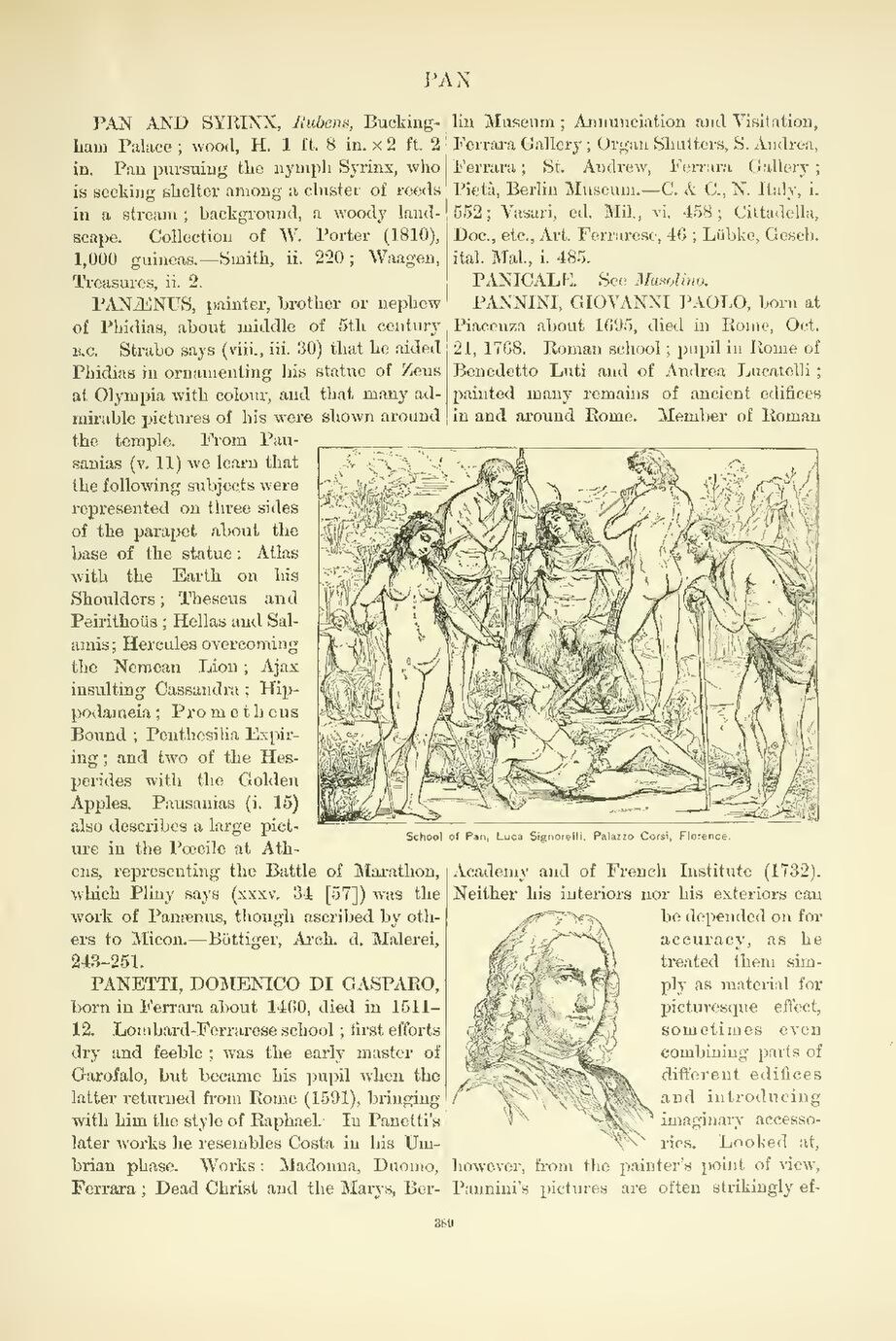PAN AND SYRINX, Rubens, Buckingham Palace; wood, H. 1 ft. 8 in. × 2 ft. 2 in. Pan pursuing the nymph Syrinx, who is seeking shelter among a cluster of reeds in a stream; background, a woody landscape. Collection of W. Porter (1810), 1,000 guineas.—Smith, ii. 220; Waagen, Treasures, ii. 2.
PANÆNUS, painter, brother or nephew
of Phidias, about middle of 5th century
B.C. Strabo says (viii., iii. 30) that he aided
Phidias in ornamenting his statue of Zeus
at Olympia with colour, and that many admirable
pictures of his were shown around
the temple. From Pausanias
(v. 11) we learn that
the following subjects were
represented on three sides
of the parapet about the
base of the statue: Atlas
with the Earth on his
Shoulders; Theseus and
Peirithoüs; Hellas and Salamis;
Hercules overcoming
the Nemean Lion; Ajax
insulting Cassandra; Hippodameia;
Prometheus
Bound; Penthesilia Expiring;
and two of the Hesperides
with the Golden
Apples. Pausanias (i. 15)
also describes a large picture
in the Pœcile at Athens,
representing the Battle of Marathon,
which Pliny says (xxxv. 34 [57]) was the
work of Panænus, though ascribed by others
to Micon.—Böttiger, Arch. d. Malerei,
243-251.
PANETTI, DOMENICO DI GASPARO,
born in Ferrara about 1460, died in 1511-12.
Lombard-Ferrarese school; first efforts
dry and feeble; was the early master of
Garofalo, but became his pupil when the
latter returned from Rome (1591), bringing
with him the style of Raphael. In Panetti's
later works he resembles Costa in his Umbrian
phase. Works: Madonna, Duomo,
Ferrara; Dead Christ and the Marys, Berlin
Museum; Annunciation and Visitation,
Ferrara Gallery; Organ Shutters, S. Andrea,
Ferrara; St. Andrew, Ferrara Gallery;
Pietà, Berlin Museum.—C. & C., N. Italy, i.
552; Vasari, ed. Mil., vi. 458; Cittadella,
Doc., etc., Art. Ferrarese, 46; Lübke, Gesch.
ital. Mal., i. 485.
PANICALE. See Masolino.
An image should appear at this position in the text. To use the entire page scan as a placeholder, edit this page and replace "{{missing image}}" with "{{raw image|Cyclopedia of painters and paintings (IA cyclopediaofpain03cham).pdf/411}}". Otherwise, if you are able to provide the image then please do so. For guidance, see Wikisource:Image guidelines and Help:Adding images. |
School of Pan, Luca Signorelli, Palazzo Corsi, Florence.
An image should appear at this position in the text. To use the entire page scan as a placeholder, edit this page and replace "{{missing image}}" with "{{raw image|Cyclopedia of painters and paintings (IA cyclopediaofpain03cham).pdf/411}}". Otherwise, if you are able to provide the image then please do so. For guidance, see Wikisource:Image guidelines and Help:Adding images. |
PANNINI, GIOVANNI PAOLO, born at
Piacenza about 1695, died in Rome, Oct.
21, 1768. Roman school; pupil in Rome of
Benedetto Luti and of Andrea Lucatelli;
painted many remains of ancient edifices
in and around Rome. Member of Roman
Academy and of French Institute (1732).
Neither his interiors nor his exteriors can
be depended on for
accuracy, as he
treated them simply
as material for
picturesque effect,
sometimes even
combining parts of
different edifices
and introducing
imaginary accessories.
Looked at,
however, from the painter's point of view,
Pannini's pictures are often strikingly ef-
